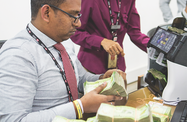Following several years of high lending, hiked interest rates and the pursuit of Basel III compliance, credit growth in Sri Lanka could slow this year and into 2018.

Credit where due
On the back of government efforts to stimulate growth in the economy, private sector credit expanded by 18% last year and by just over 20% in 2015.
However, in a move aimed at reducing excessive credit expansion and inflationary pressures, in March the Central Bank of Sri Lanka (CBSL) increased both its standing deposit facility rate and its standing lending facility rate by 25 basis points, bringing them to 7.5% and 8.75%, respectively.
In addition to interest rate growth, Sri Lanka’s banks may find expanding their loan books a challenge due to tax hikes implemented earlier this year, according to a report issued by ratings agency Fitch last month.
Confirming the sector’s negative outlook for the year, the ratings agency suggested it will face challenges due to a wider economic slowdown: GDP growth eased marginally in 2016 to 4.29%, down from 4.78% in 2015 and 4.87% in 2014, according to IMF figures. However, the IMF forecasts economic expansion of 4.8% and 4.9% in the next two years.
Fitch also noted that while Sri Lanka’s credit-to-GDP ratio has grown in recent years – from 30% in 2014 to 45% today – it is still the lowest in the region. Malaysia and Singapore, for example, both have a credit-to-GDP ratio of around 130%, while Thailand’s stands at 150%.
Uneven spread
With such aggressive lending undertaken in the previous two years, stakeholders were concerned that bubbles would develop in certain sectors.
It is possible that these fears have been borne out, with Indrajit Coomaraswamy, governor of the CBSL, recently voicing the central bank’s suspicion that some credit lines intended as support mechanisms for the development of small and medium-sized enterprises have fed into the real estate industry.
Talking to local media in May, Coomaraswamy noted that the bank had not yet decided on a course of action, but suggested the bank could move to take macro-prudential measures to slow the property market to put it on a “more sustainable growth path”.
Capital pressures
Observers have also noted that high dividend payments have reduced capital buffers among some of Sri Lanka’s banks. The three largest banks – the National Savings Bank, Bank of Ceylon and People's Bank Sri Lanka – paid 76% of their profits as dividends last year.
Thin capitalisation could take on increased significance as the sector moves towards meeting the requirements of Basel III, which are set to come into effect at the beginning of 2019.
Under the requirements of Basel III, local banks will have to maintain a minimum of 7% in risk-weighted assets (RWAs) under common equity Tier-1 (CET 1); Tier-1 capital of at least 8.5%; as well as total capital (CET 1, additional Tier-1 and Tier-2 capital) of at least 12.5%, up from the current minimum of 10%.
Banks designated as systemically important – that is, those with more than LKR500bn ($3.4bn) in assets – will also be required to have an additional buffer of 1.5% in RWAs. Six banks currently meet this criterion, according to CBSL data.
Ratings agency S&P has also warned about the risk to capital buffers stemming from high loan growth, which it said could negatively impact banks’ already declining capital levels.
“This may further reduce the buffers required to absorb the pain that could come from worsening asset quality,” the agency said in a statement issued at the end of the first quarter.
Indeed, non-performing loans rose by 7% in the first three months of the year, according to Fitch.
Requirements to build capital reserves and deteriorating portfolios may see some banks curb their loan activity in the lead up to the 2019 deadline, potentially resulting in falls in revenue and dividends as they shore up their fiscal position at the expense of earnings from lending.


